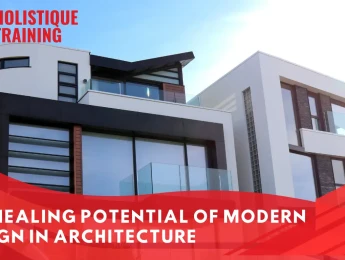- Table of Contents
- Introduction
- What is Modernism in Architecture?
- The Principles of Modernism in Architecture
- 1. Simplicity and Clarity
- 2. Functionality Above All
- 3. Use of Modern Materials
- 4. Integration with Nature
- 5. Open Floor Plans
- 6. Minimalist Aesthetic
- 7. Emphasis on Innovation and Technology
- How Does Modern Architecture Affect Health and Healing?
- Promotes Physical Health Through Better Air Quality and Ventilation
- Enhances Mental Well-Being with Natural Light
- Reduces Stress Through Connection to Nature
- Encourages Movement and Physical Activity
- Improves Emotional Healing Through Open, Flexible Spaces
- Facilitates Healing in Healthcare Environments
- Boosts Creativity and Productivity in Workspaces
- Creates Inclusive and Accessible Environments
- Case Study: Modern Architecture and Healing
- The Open-Space Concept of Workspaces and Its Effect on Work Culture
- Encourages Collaboration and Teamwork
- Enhances Transparency and Trust
- Boosts Creativity and Innovation
- Increases Productivity and Engagement
- Fosters a Sense of Community and Inclusivity
- Promotes Health and Well-Being
- Challenges of Open-Space Work Environments
- Case Study: Open-Space Concepts in Action
- Steps to Start Accommodating Modern Architecture in Everyday Life
- 1. Embrace Minimalism
- 2. Prioritize Natural Light
- 3. Introduce Open-Plan Living
- 4. Incorporate Sustainable Materials
- 5. Incorporate Nature Indoors
- 6. Invest in Modern Furniture and Design Features
- 7. Start Small with Modern Architectural Features
- 8. Leverage Technology for Smart Living
- 9. Engage with Professionals
- 10. Focus on Community Spaces
- Challenges of Modern Architecture
- Conclusion
Introduction
Architecture has long been more than just a means of shelter; it shapes how we live, work, and even heal. As societies evolve, so does architectural philosophy, with modernism emerging as a transformative approach. This blog explores how modernist principles contribute to health and healing—physically, emotionally, and socially. We'll delve into its defining elements, benefits, and challenges while examining how it impacts workspaces and everyday life.
What is Modernism in Architecture?
Modernism in architecture is a movement that emerged in the late 19th and early 20th centuries as a response to rapid industrialization and societal change. Rooted in innovation and simplicity, modernism sought to break away from traditional design, embracing functionality and the use of new materials and construction techniques.
Modernist architecture emphasizes minimalism, clean lines, and open spaces, reflecting a " form follows function " philosophy. It rejects excessive ornamentation, focusing instead on creating purposeful structures that harmonize with their environment and meet human needs. Iconic figures like Le Corbusier , Ludwig Mies van der Rohe , and Frank Lloyd Wright championed this approach, leaving behind structures that continue to influence architectural design globally.
Table: Modernism in architecture: then vs. now
Aspect | Modernism Then | Modernism Now |
Materials | Focused on steel, glass, concrete | Includes eco-friendly, sustainable materials |
Design Philosophy | Minimalism with functional simplicity | Blends minimalism with biophilic elements |
Technology Integration | Limited due to technological constraints | Emphasizes smart systems and automation |
Space Usage | Open layouts for flexibility | Multi-functional spaces for adaptability |
Environmental Impact | Energy-intensive, lacked eco-awareness | Prioritizes energy efficiency and green design |
The Principles of Modernism in Architecture
Modernism in architecture is defined by its distinct principles, which focus on creating purposeful, human-centered spaces. These principles not only influence aesthetics but also aim to enhance functionality, efficiency, and the overall well-being of occupants. Here, we explore these key principles:
1. Simplicity and Clarity
At the heart of modernism lies a commitment to simplicity. Unlike the ornate designs of previous architectural movements, modernism avoids excessive decoration and intricate details, focusing instead on clean, straightforward forms.
- Visual Harmony: Structures are designed with clear geometrical shapes and balanced proportions, creating a sense of visual calm.
- Practicality: Every design choice serves a purpose, ensuring there is no clutter or redundancy.
This emphasis on simplicity also extends to materials, colors, and finishes, which are often understated to create a sense of clarity and order.
2. Functionality Above All
Modernist architecture is guided by the mantra "form follows function," meaning the design of a building or space is dictated by its intended use. This principle ensures:
- Efficient Layouts: Spaces are planned to accommodate specific activities, making them highly practical.
- Usability for All: Buildings are designed to meet the needs of their users, whether for living, working, or healing.
For example, hospitals built with modernist principles often include wide corridors, ample natural light, and flexible spaces to improve patient care and staff efficiency.
3. Use of Modern Materials
Modernism embraced the technological advancements of its time, incorporating new materials such as steel, reinforced concrete, and glass. These materials revolutionized construction, enabling architects to create designs that were previously impossible.
- Steel: Allowed for taller structures and sleeker designs, giving rise to skyscrapers.
- Glass: Enabled expansive windows and transparent facades, blurring the boundary between indoor and outdoor spaces.
- Concrete: Provided strength and versatility, making it possible to experiment with bold shapes and open layouts.
These materials are not just practical—they also contribute to the aesthetic of modernism by highlighting the beauty of raw, unadorned surfaces.
4. Integration with Nature
Modernism places a strong emphasis on connecting buildings with their natural surroundings, a concept known as biophilic design.
- Maximizing Natural Light: Large windows, open layouts, and skylights bring daylight into interiors, reducing the need for artificial lighting and improving occupant well-being.
- Outdoor Spaces: Many modernist buildings include terraces, courtyards, and gardens, creating spaces where people can relax and interact with nature.
- Harmonizing with the Environment: Buildings are often designed to complement, rather than dominate, their surroundings.
For instance, Frank Lloyd Wright’s famous "Fallingwater" house integrates seamlessly with its forested setting and even incorporates a waterfall into its design.
5. Open Floor Plans
Modernism challenges the idea of rigid, compartmentalized spaces by prioritizing open floor plans that allow for greater flexibility and adaptability.
- Freedom of Movement: Open layouts facilitate a smooth flow of movement within a space, making it feel more expansive and less confined.
- Multi-Functional Spaces: Rooms can serve multiple purposes, adapting to the changing needs of occupants over time.
- Collaboration and Connection: In workplaces, open layouts encourage communication and teamwork by removing physical barriers.
This principle is particularly evident in modern homes and offices, where living areas, kitchens, and dining spaces often merge into a single cohesive environment.
6. Minimalist Aesthetic
Modernist design rejects excess, embracing a minimalist aesthetic that emphasizes "less is more." This approach focuses on:
- Neutral Color Palettes: Shades like white, gray, and beige dominate modernist interiors, creating a timeless and calming atmosphere.
- Streamlined Furniture: Furnishings are designed with simplicity and functionality in mind, often featuring geometric shapes and high-quality materials.
- Elimination of Superfluous Details: The absence of unnecessary ornamentation highlights the beauty of the structure itself.
This minimalist aesthetic not only creates visually pleasing spaces but also fosters a sense of mental clarity and focus for those who inhabit them.
7. Emphasis on Innovation and Technology
Modernist architects embraced technological advancements, integrating them into their designs to improve functionality and efficiency.
- Smart Designs: Many modernist structures are equipped with innovative systems for heating, cooling, and energy management.
- Adaptability: Modern buildings are often designed to accommodate future technologies, ensuring they remain relevant over time.
The combination of these principles results in spaces that are not only architecturally striking but also deeply attuned to the needs of the people who use them. Modernism’s emphasis on simplicity, functionality, and harmony with nature has made it a powerful tool for improving health, productivity, and quality of life.
How Does Modern Architecture Affect Health and Healing?
Modern architecture, with its thoughtful design principles and focus on human well-being, has a profound impact on health and healing. By integrating functionality, aesthetics, and nature, modernist spaces create environments that nurture both the physical and mental well-being of their occupants. Below is a detailed exploration of how modern architecture contributes to health and healing:
Promotes Physical Health Through Better Air Quality and Ventilation
Modern architecture emphasizes designs that prioritize clean air circulation and effective ventilation systems. These elements significantly contribute to physical health in the following ways:
- Natural Ventilation: Open layouts, large windows, and well-positioned ventilation systems ensure fresh air circulation, reducing the buildup of pollutants and allergens indoors.
- Reduced Illnesses: Improved airflow helps decrease the spread of airborne illnesses, especially in communal spaces such as offices, hospitals, and schools.
- Material Choices: Modernist architects often use low-VOC (volatile organic compound) materials, which minimize harmful emissions, contributing to healthier indoor air quality.
In healthcare settings, such as hospitals, these principles are crucial for patient recovery, as clean air can prevent infections and promote faster healing.
Enhances Mental Well-Being with Natural Light
Access to natural light is a hallmark of modern architecture and a key factor in fostering mental health. Sunlight is essential for regulating the body’s circadian rhythm and boosting mood.
- Biological Benefits: Exposure to natural light increases serotonin levels, which helps reduce stress and combat conditions like Seasonal Affective Disorder (SAD).
- Improved Sleep Patterns: Sunlit spaces encourage healthier sleep cycles, improving overall well-being.
- Workplace Productivity: In offices, abundant natural light has been linked to increased focus, reduced fatigue, and higher employee satisfaction.
Hospitals, for instance, often incorporate large windows and skylights in patient rooms to accelerate recovery and create a calming environment.
Reduces Stress Through Connection to Nature
Modern architecture often incorporates biophilic design principles, which emphasize the connection between humans and nature. This connection has a calming effect, reducing stress and promoting relaxation.
- Green Spaces: The inclusion of gardens, terraces, and indoor plants brings the healing power of nature into everyday environments.
- Visual Comfort: Open designs with views of natural landscapes or water bodies can lower blood pressure and stress levels, contributing to better overall health.
- Restorative Environments: Healthcare facilities designed with biophilic elements, such as healing gardens or atriums filled with greenery, have been shown to improve patient outcomes and reduce recovery times.
Encourages Movement and Physical Activity
Modern architectural designs often include features that promote physical activity, which is essential for maintaining health and preventing chronic conditions.
- Staircases Over Elevators: Sleek, open staircases in public spaces encourage people to use stairs instead of elevators, fostering cardiovascular health.
- Walkable Spaces: Mixed-use developments and open layouts encourage walking and exploration, reducing sedentary behavior.
- Functional Pathways: Hospitals and wellness centers integrate carefully designed pathways for both patients and caregivers, encouraging gentle movement that supports recovery.
Improves Emotional Healing Through Open, Flexible Spaces
Modernist open layouts, with their fluid and adaptable nature, create environments that foster emotional well-being by promoting interaction and reducing feelings of confinement.
- Collaboration and Social Connection: Open-plan offices and communal spaces encourage social interaction, reducing feelings of isolation and fostering a sense of community.
- Freedom of Movement: Flexible spaces allow people to move freely, reducing the psychological stress often associated with rigid and confined environments.
- Comfortable Environments: Spacious and adaptable interiors, with calming colors and uncluttered designs, create peaceful atmospheres that aid emotional recovery, especially in settings like homes and therapy centers.
Facilitates Healing in Healthcare Environments
Modernist principles have revolutionized healthcare architecture, making it more patient-centered and healing-focused.
- Patient-Centered Design: Hospitals are increasingly designed to feel less clinical and more comforting, with private rooms, natural materials, and homely touches.
- Noise Reduction: Modernist designs often include soundproofing measures to reduce noise levels, which can improve patient recovery and staff performance.
- Wayfinding: Clear, intuitive layouts minimize confusion and stress for patients and visitors.
For instance, many modern hospitals include large atriums, green spaces, and calming artwork to create a more welcoming environment conducive to healing.
Boosts Creativity and Productivity in Workspaces
Modern architecture’s emphasis on open, adaptable spaces and natural light enhances workplace productivity and creativity.
- Stimulates Innovation: Bright, airy spaces with minimal distractions inspire creative thinking and problem-solving.
- Supports Mental Resilience: Comfortable, thoughtfully designed offices contribute to employee satisfaction and resilience, reducing burnout.
In workplaces, employees in well-designed modernist spaces report higher engagement and lower stress levels, directly impacting organizational success.
Creates Inclusive and Accessible Environments
Modern architecture is inherently inclusive, striving to accommodate individuals with diverse physical and mental needs.
- Accessibility Features: Ramps, elevators, wide doorways, and tactile elements ensure that spaces are accessible to everyone, including those with disabilities.
- Universal Design: By focusing on adaptability, modern spaces cater to a wide range of users, fostering a sense of belonging and inclusivity.
This inclusivity is especially important in public buildings, schools, and healthcare facilities, where accessibility is paramount.
Case Study: Modern Architecture and Healing
A notable example of modern architecture’s impact on healing is the Maggie’s Centres in the UK, designed to support individuals living with cancer. These centers feature open, light-filled spaces, vibrant greenery, and soothing aesthetics. Patients and their families often describe the spaces as uplifting and comforting, offering a sense of peace during challenging times.
By incorporating modernist principles, Maggie’s Centres exemplify how thoughtful architectural design can profoundly influence mental and emotional healing.
Modern architecture, with its focus on light, space, nature, and adaptability, demonstrates the power of design to influence health and healing. Whether in homes, workplaces, or healthcare settings, these principles create environments that nurture the body and mind, making modern architecture a true tool for well-being.
The Open-Space Concept of Workspaces and Its Effect on Work Culture
The open-space concept in modern architecture has redefined how people work, interact, and thrive in their professional environments. By moving away from traditional closed-off cubicles and private offices, this approach promotes a collaborative, inclusive, and flexible work culture. The design philosophy emphasizes openness, transparency, and human connection, fundamentally altering how organizations operate and how employees feel about their workspaces.
Here is how open-space designs affect work culture:
Encourages Collaboration and Teamwork
Open-space work environments are designed to break down physical barriers, fostering collaboration and communication among employees.
- Shared Spaces: Large, open areas encourage employees to share ideas and problem-solve together, creating a more collaborative culture.
- Accessibility to Leaders: The absence of hierarchical office layouts makes management more approachable, encouraging open dialogue and feedback.
- Cross-Department Interaction: By integrating different teams into the same physical space, open-plan offices facilitate cross-functional collaboration and innovative thinking.
For example, many tech companies, like Google, have embraced open layouts to stimulate creativity and innovation, reflecting their dynamic and collaborative cultures.
Enhances Transparency and Trust
An open-space concept fosters a sense of transparency within an organization, as employees can see and engage with each other more easily.
- Visible Workflow: Employees gain insight into each other's work, promoting accountability and a shared sense of purpose.
- Open Communication: Conversations and exchanges are more fluid, which reduces misunderstandings and strengthens team trust.
- Leadership Visibility: When leaders work in the same open space as their teams, it demonstrates inclusivity and reinforces a culture of equality.
This sense of transparency can also build stronger connections among employees, as they feel more aligned with the organization's goals and values.
Boosts Creativity and Innovation
Open layouts often include shared brainstorming zones, breakout areas, and informal meeting spaces that stimulate creative thinking.
- Idea Sharing: Employees are more likely to exchange ideas organically when physical barriers are removed, leading to innovative solutions.
- Flexible Work Zones: Modern open spaces often include movable furniture and modular layouts, allowing employees to create setups that suit their needs for brainstorming or solo work.
- Serendipitous Interactions: The chance for unplanned conversations in communal areas can lead to spontaneous collaboration and innovation.
For instance, many advertising agencies design their workspaces with creative pods and open brainstorming hubs to encourage out-of-the-box thinking.
Increases Productivity and Engagement
Contrary to the belief that open spaces might distract employees, well-designed layouts can actually enhance productivity when paired with thoughtful features.
- Natural Light and Ergonomics: Modern open offices prioritize access to natural light, ergonomic furniture, and calming aesthetics, creating an environment that promotes focus and comfort.
- Zones for Focus: While the overall layout is open, quiet zones or soundproof pods can be incorporated for tasks requiring deep concentration.
- Sense of Purpose: Employees who feel connected to their peers and leaders are more likely to feel engaged and motivated.
When the design is balanced between collaboration and focus, employees often report higher job satisfaction and efficiency.
Fosters a Sense of Community and Inclusivity
The open-space concept helps dissolve traditional hierarchies, creating a workplace culture rooted in inclusivity and equality.
- Equal Access: All employees, regardless of position, share the same open environment, promoting a sense of equality.
- Cultural Exchange: Shared spaces encourage diverse interactions, allowing employees to learn from one another’s perspectives and backgrounds.
- Community Building: Breakout areas and communal spaces act as hubs where employees can build relationships, fostering a stronger sense of belonging.
This communal spirit often translates to higher employee retention rates, as workers feel more connected to their teams and the organization.
Promotes Health and Well-Being
Open workspaces designed with modern architectural principles incorporate features that contribute to employee health and well-being .
- Movement-Friendly Layouts: Spacious designs encourage walking and mobility, reducing the health risks of a sedentary lifestyle.
- Stress Reduction: Access to natural light, greenery, and aesthetically pleasing interiors creates a calming environment that helps reduce workplace stress.
- Social Support: Opportunities for casual conversations and peer interaction help employees feel supported and valued, reducing feelings of isolation.
By prioritizing employee well-being, open-space designs contribute to a healthier, happier workforce, which directly impacts productivity and morale.
Challenges of Open-Space Work Environments
Despite the numerous benefits, the open-space concept does come with challenges that organizations need to address for it to work effectively:
- Noise Levels: Open layouts can be noisy, which may affect concentration and productivity. Implementing soundproof zones or quiet areas can help mitigate this issue.
- Privacy Concerns: Employees may feel a lack of privacy in open layouts. Introducing private meeting rooms or phone booths can balance openness with the need for discretion.
- Distractions: While openness promotes collaboration, it can also lead to distractions. Creating dedicated focus areas or offering noise-canceling tools can help maintain a productive atmosphere.
Organizations need to carefully design their open-space environments to strike a balance between openness, functionality, and employee comfort.
Case Study: Open-Space Concepts in Action
A prime example of successful open-space design is Apple’s headquarters, Apple Park. The building features large, open areas, shared workspaces, and plenty of natural light, reflecting Apple’s commitment to collaboration and innovation. Employees often report feeling more connected and inspired within the space, highlighting how modern architecture can influence work culture.
Similarly, coworking spaces like WeWork have embraced open layouts, incorporating shared desks, collaborative areas, and community-focused zones. These designs have become particularly popular among startups and freelancers, emphasizing the value of connectivity and flexibility in modern work environments.
The open-space concept of workspaces has transformed the way we perceive and experience work. By prioritizing collaboration, transparency, creativity, and well-being, these designs foster a work culture that is dynamic, inclusive, and forward-thinking. With thoughtful implementation, organizations can leverage open-space principles to create environments that not only reflect their values but also empower their employees to thrive.
Steps to Start Accommodating Modern Architecture in Everyday Life
Integrating modern architectural principles into your everyday life doesn't necessarily require a complete overhaul of your home, workspace, or community. Instead, it involves gradually adopting design elements and philosophies that prioritize functionality, simplicity, sustainability, and well-being. Below are practical and detailed steps to incorporate modern architecture into your daily living:
1. Embrace Minimalism
Modern architecture thrives on the principle of "less is more." Simplifying your surroundings can create a sense of order, spaciousness, and tranquility.
- Declutter Regularly: Begin by removing items that no longer serve a purpose or add value to your space. This helps create cleaner, more open spaces.
- Choose Functional Furniture: Opt for furniture that serves multiple purposes, such as a sofa bed or storage ottoman, to maximize efficiency and reduce unnecessary items.
- Streamline Décor: Use a minimal color palette and avoid over-accessorizing. A few carefully chosen decorative elements can enhance the aesthetic without overwhelming the space.
2. Prioritize Natural Light
One of the most healing and transformative aspects of modern architecture is its emphasis on natural light.
- Maximize Windows: Keep windows unobstructed by heavy curtains or furniture to allow sunlight to flood the room.
- Use Reflective Surfaces: Incorporate mirrors or glossy finishes to amplify natural light and make spaces feel brighter and more open.
- Install Skylights: If possible, add skylights or light tubes to bring natural light into previously dim areas, such as hallways or kitchens.
Exposure to natural light improves mood, boosts productivity, and reduces energy consumption, aligning with the sustainable ethos of modernism.
3. Introduce Open-Plan Living
Modern architecture emphasizes open and flexible spaces that flow seamlessly.
- Combine Living Areas: Remove unnecessary walls to merge areas like the kitchen, dining, and living room, creating a sense of unity and openness.
- Use Furniture to Define Spaces: Instead of walls, use rugs, furniture placement, or shelving units to delineate different zones within an open-plan layout.
- Create Multi-Functional Spaces: Transform a single room into a space that serves multiple purposes, such as a home office that doubles as a guest room.
Open-plan designs encourage interaction, adaptability, and efficient use of space, which aligns with contemporary lifestyles.
4. Incorporate Sustainable Materials
Sustainability is a cornerstone of modern architecture, and using eco-friendly materials is a simple yet impactful way to adopt its principles.
- Choose Natural Materials: Opt for wood, bamboo, stone, or recycled materials for flooring, furniture, and finishes. These not only look timeless but are also environmentally friendly.
- Use Energy-Efficient Products: Replace traditional light bulbs with LEDs, install energy-efficient appliances, and consider solar panels for long-term savings and reduced environmental impact.
- Invest in Green Building Materials: If renovating, consider materials like recycled steel, reclaimed wood, or low-VOC paints to ensure a sustainable and healthy living environment.
5. Incorporate Nature Indoors
Modern architecture often blurs the line between indoor and outdoor spaces, fostering a closer connection to nature.
- Add Indoor Plants: Bring greenery into your home with low-maintenance indoor plants like pothos, succulents, or peace lilies. These not only purify the air but also create a calming ambiance.
- Use Natural Textures: Incorporate materials like jute, rattan, or linen to introduce a tactile connection to nature.
- Create Outdoor Extensions: Build patios, decks, or garden areas that flow seamlessly from indoor spaces, offering relaxation and rejuvenation.
This integration of biophilic design principles can significantly enhance mental well-being and promote a sense of harmony.
6. Invest in Modern Furniture and Design Features
Modern architecture thrives on clean lines, simplicity, and functionality, all of which can be reflected in your choice of furniture and décor.
- Opt for Sleek Designs: Choose furniture with clean, straight lines and neutral colors to embody the essence of modern design.
- Focus on Comfort and Usability: Functional furniture that enhances comfort, such as ergonomic chairs or modular sofas, aligns with the practical side of modernism.
- Highlight Geometric Patterns: Use geometric shapes in your furniture, wall art, or flooring to echo the structural emphasis of modern architecture.
7. Start Small with Modern Architectural Features
If large-scale changes aren’t feasible, begin with small modifications that reflect modern design principles.
- Update Fixtures: Replace outdated light fixtures, faucets, or door handles with modern, streamlined designs.
- Reimagine Storage: Introduce hidden storage solutions like built-in cabinets or under-bed drawers to maintain a clutter-free environment.
- Enhance Entryways: Revamp your entrance with minimalist doors, sleek hardware, or a simple but elegant lighting fixture to create a modern first impression.
8. Leverage Technology for Smart Living
Modern architecture is intertwined with technological advancements that make spaces more intelligent and efficient.
- Install Smart Systems: Use smart thermostats, lighting, and security systems to enhance convenience and energy efficiency.
- Adopt Voice-Controlled Devices: Integrate virtual assistants like Alexa or Google Home to manage various aspects of your home seamlessly.
- Automate Windows: Motorized blinds or curtains can adjust lighting and privacy settings automatically, aligning with the adaptive nature of modern design.
Smart living solutions not only save time but also optimize energy use, making them an integral part of modern architectural living.
9. Engage with Professionals
Sometimes, professional guidance can make the transition smoother and more impactful.
- Hire an Architect or Designer: Seek out experts who specialize in modern architecture to help redesign your space with an emphasis on functionality and aesthetics.
- Consult Sustainability Specialists: If eco-friendliness is a priority, work with consultants who can guide you on energy-efficient and sustainable materials.
- Explore Modern Furniture Retailers: Many furniture companies offer modern, customizable designs that can suit your specific space and style preferences.
10. Focus on Community Spaces
Modern architecture isn’t limited to private homes; it can extend to shared community spaces as well.
- Upgrade Common Areas: Advocate for modern designs in public spaces like parks, libraries, and schools to benefit the broader community.
- Design Co-Living Spaces: For those living in shared housing, create open common areas that encourage interaction and foster a sense of community.
- Promote Green Spaces: Support initiatives to integrate urban green spaces, rooftop gardens, and sustainable buildings into your city.
By taking these incremental steps, you can seamlessly accommodate modern architectural principles into your everyday life. Whether through minimal adjustments or more significant renovations, these changes can transform your surroundings into spaces that are not only visually appealing but also functional, sustainable, and conducive to health and well-being.
Challenges of Modern Architecture
Despite its numerous advantages, modern architecture is not without its challenges, some of which are:
Challenge | Description |
Cultural Resistance | Traditional architecture's cultural importance can hinder modernism's acceptance in certain regions |
Sustainability Concerns | Glass and steel usage increases energy consumption; sustainable practices can help mitigate this |
Overemphasis on Minimalism | Overly sterile designs may lack warmth; balancing simplicity with personality is essential |
Cost | Modern designs require advanced materials and techniques, making them expensive to implement |
Conclusion
Modernism in architecture offers more than just aesthetic appeal—it serves as a tool for healing and enhancing the human experience. By embracing principles like simplicity, functionality, and a connection to nature, modernist designs promote physical, mental, and emotional well-being. Whether through open workspaces or sunlight-filled homes, modern architecture encourages harmony between people and their environment.
While challenges like cost and sustainability must be addressed, the potential of modernism to create healthier, more inspiring spaces is undeniable. By incorporating its principles into everyday life, we can craft environments that uplift and heal—spaces that reflect the best of human ingenuity and care.
If you're passionate about creating spaces that foster well-being, our course, Designing for Mental Health: Architecture and Wellbeing , is the perfect opportunity to explore the intersection of design and mental health. Learn how to apply modernist principles to craft environments that promote healing, productivity, and happiness. Enroll today to gain insights from industry experts and become a leader in the movement toward architecture that truly cares.






















